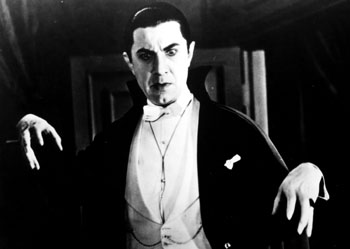![[Metroactive Movies]](http://metroactive.com/movies/gifs/movies468.gif)
[ Movies Index | Show Times | Silicon Valley | Metroactive Home | Archives ]
Bite Marks
The new 'Legacy Collection' of classic 'Dracula' films proves that old monsters never die, they just go to DVD
By Richard von Busack
THIS 1979 tune, the "Smells Like Teen Spirit" of goth music, has been airing on KALX so much that I wonder if the DJs got their hands on the two-disc Dracula: The Legacy Collection. While the other Monster Legacy collections (The Wolf Man and Frankenstein) have their points, the Dracula set is particularly full of bells and whistles, containing at least four and maybe five movies starring the emperor of vampires.
Does the Spanish-language version of Dracula count as a separate film or not? George Melford's Spanish Drácula was shot by night on the same castle, drawing room and ruined abbey sets where the 1931 Tod Browning/Lugosi film was being shot during the day. Although it's 19 minutes longer than the Browning version, Melford's film gives the impression of being a much faster movie. Browning's creaky camera work, lack of crosscutting and snail-like pacing almost overcomes the nocturnal power of photographer Karl Freund--let alone the ravenous Lugosi.
Taking the radical expedient of moving the camera a little, Medford climbs the stairs to meet Carlos Villarías' Dracula, posed before a monumental spider web. Villarías bears an unignorable resemblance to Peter Sellers, but at least he seems to have a little fun with playing with his food.
When insulted by the mortals trying to keep him at bay, Lugosi ignores them, staring right through them, into eternity. Villarías, by contrast, projects humorous injured dignity. Unlike Browning's Mina (Helen Chandler), the Spanish-language Mina, called Eva (Lupita Tovar, who is interviewed on the bonus tracks), isn't swathed in the kind of nightie one would buy as a birthday present for Grandma. The gusty cackling of the Spanish Renfield delivers its own pleasures, though there is only one Dwight Frye. The true moment of horror in both versions is the same: the instant where Renfield, barely able to control his excitement, blurts out that his master is just about to promote him from insectivore to rat eater.
The Spanish ending is a highlight. Browning loses track of Van Helsing, finishing with an overhead shot of his romantic leads emerging up the stairs of Carfax Abbey into daylight. By contrast, Melford goes for a long, wide shot. The couple ascends. Below them, in a halo of light, Van Helsing tends the body of the wretched Renfield, where his corpse lies, broken on the stones. For some, there is happiness. For others, there is the crypt, the stake, a life matching wits with the undead.
Of course, what the Melford version doesn't have is Lugosi, especially that V-shaped smile, giving a strange illusion of toothlessness, as if his mouth were a vortex. No one forgets Lugosi, his voice wobbling with emotion, as he praises the singing of the wolves of Transylvania. Browning's direction may be stagy, but Lugosi gives a performance outside of time as Dracula.
The further adventures of the Dracula family on the DVD includes John "Man of a 1,000 Movies" Carradine as the touchingly suffering vampire in House of Dracula (1945). Alas, the movie is a true barbiturate. Dracula's Daughter (1936) is much celebrated for its lesbian incident, when the Countess Zaleska (Gloria Holden) vamps a pathetic London street girl, after first stripping her to her chemise. Otherwise, the countess is resolutely heterosexual, and the show is stolen by Irvin Pichel as her servant Sandor, a would-be vampire. The sepulchral actor/director (co-director, in fact, of the terrific adventure film The Most Dangerous Game) is as haunted-looking as Benicio Del Toro.
Son of Dracula (1943) stands out as the best of the follow-ups. Its director, the German refugee Robert Siodmak, was a leading light (or leading shadow) in film noir. In the title role, Lon Chaney Jr. displays a cornfed accent, and I'm sorry to say, he's disguised himself as "Count Alucard" (a gaffe explained to the satisfaction of the most dyslexic). Despite these drawbacks, Chaney's contribution to the role and lore of the count is a sense of brute strength. Lugosi beckons; Chaney grabs and strangles. The interesting locale is a Louisiana bayou, where the count uses a mental hold to take over the plantation of an heiress (Louise Allbritton). In the 1930s, Dracula was a bloodsucking aristo; in the 1940s, he's a land-grabbing Nazi.
And in Stephen Sommers' less-than-deathless Van Helsing, Dracula might as well be a prop. The Monster Legacy series was brought out to tag along on this summer's monster release. While much of what we see here has aged to the point of quaintness, there are elements that may prove to be more deathless than the vogue for making movies that look like video games.
[ Silicon Valley | Metroactive Home | Archives ]
Copyright © Metro Publishing Inc. Metroactive is affiliated with the Boulevards Network.
For more information about the San Jose/Silicon Valley area, visit sanjose.com.
![]()

For Whom the Bela Tolls: Original bad boy Bela Lugosi still defines our ideas about Count Dracula.
The bats have left the bell tower
The victims have been bled
Red velvet lines the black box
Bela Lugosi's dead.
Bauhaus, 'Bela Lugosi's Dead'
Send a letter to the editor about this story to letters@metronews.com.
From the June 23-29, 2004 issue of Metro, Silicon Valley's Weekly Newspaper.